
General Dentistry: Direct Mail Response Rates & New Patient ROI
Marketing is your investment in the future growth of your dental practice. Like any potential investment, it’s critical you understand all the numbers that have an impact on your return on investment (ROI).
In Part 1 of this guide, we will discuss and demonstrate how to calculate the true value of each new patient that visits your dental practice.
In Part 2, we will take an in-depth look into dental practice direct mail response rates and show you how to forecast your potential direct mail ROI.
Finally, we will provide you with our “Dental Practice Direct Mail ROI Calculator.” This powerful tool gives you the ability to input your practice’s numbers to create a transparent analysis of the potential ROI direct mail can produce specifically for your practice.
How To Calculate The Value Of A New Patient
One of the biggest mistakes many dental practices make when determining the production of their new patients is only looking at how much a new patient spends on their first visit. This is fundamentally wrong for a couple of reasons.
For starters, new patients may not have an immediate need for a major treatment or procedure. In addition, you will be overlooking the production from future treatments and procedures that can only come over time.
Therefore, it’s critical that you look beyond the amount your new patients spend on their first visit and assign them a value based on their lifetime value (LTV).
Your patient LTV represents the dollar amount each new patient is expected to spend during the entire duration of time they are a patient at your practice. Your patient LTV is also the number you must compare against your marketing expense. Having a full grasp of this number will allow you to make strategic decisions about your marketing budget, including:
- What marketing efforts are paying off.
- How much you should spend to acquire a new patient.
- Whether you are generating the best ROI.
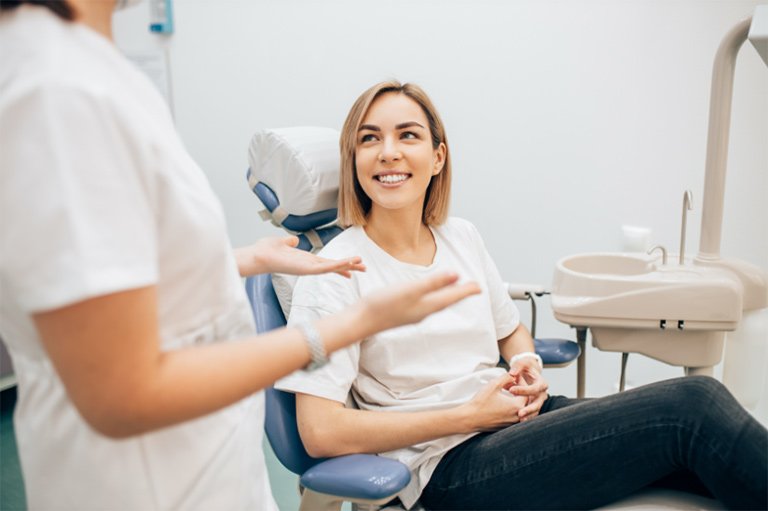
How to Calculate your Patient Lifetime Value (LTV)
For our example, we consulted with one of our general dentistry direct mail clients, Dr. Jeffrey Grove of Grove Dental, located in Wyomissing, PA. Grove Dental has been serving its local community for over 40 years and is one of the top practices in the area.
To begin, we must determine the following:
Step 1:
The average length that a patient will stay with your practice.
Grove Dental Example: 10 Years
Step 2:
The average amount each patient spends over the course of one year.
Grove Dental Example: $695
(This was calculated by taking Grove Dental’s total production in 2018 divided by the number of its active patients.)
After inputting these numbers, you can see that each new patient is actually worth $6,950 over the time they remain a patient at Grove Dental.
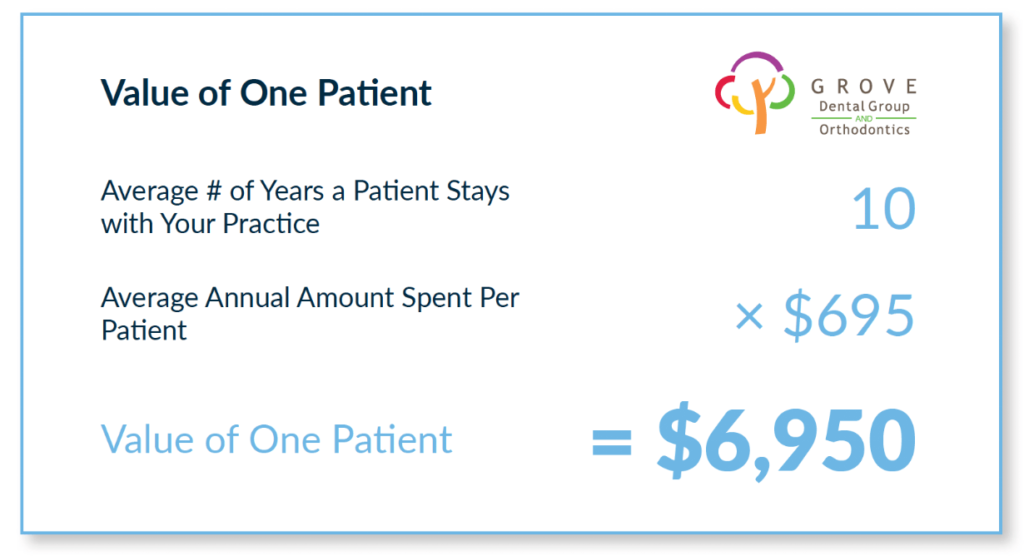
Now that we have determined the true value of one patient, there is another important part of the calculation which most practices overlook: production from patient referrals.
The Value of Patient Referrals
All well-run dental practices will receive referrals from their happy patients. Referrals typically remain the number one lead source for many of the busiest practices across the country.
These referrals can be other family members, friends, or colleagues. We asked Dr. Grove to provide us with the average number of referrals his practice receives from their patients.
Grove Dental Example:
Based on the number of new patients referred to Grove Dental in 2018 divided by the number of their active patients, Grove Dental received an average of 1.4 referrals per patient in 2018.
As you can see in the example below, if the value of one patient is $6,950, and each patient refers an average of 1.4 of their family members, friends, colleagues, etc., that’s another $9,730 of production from these referrals that will come over time.
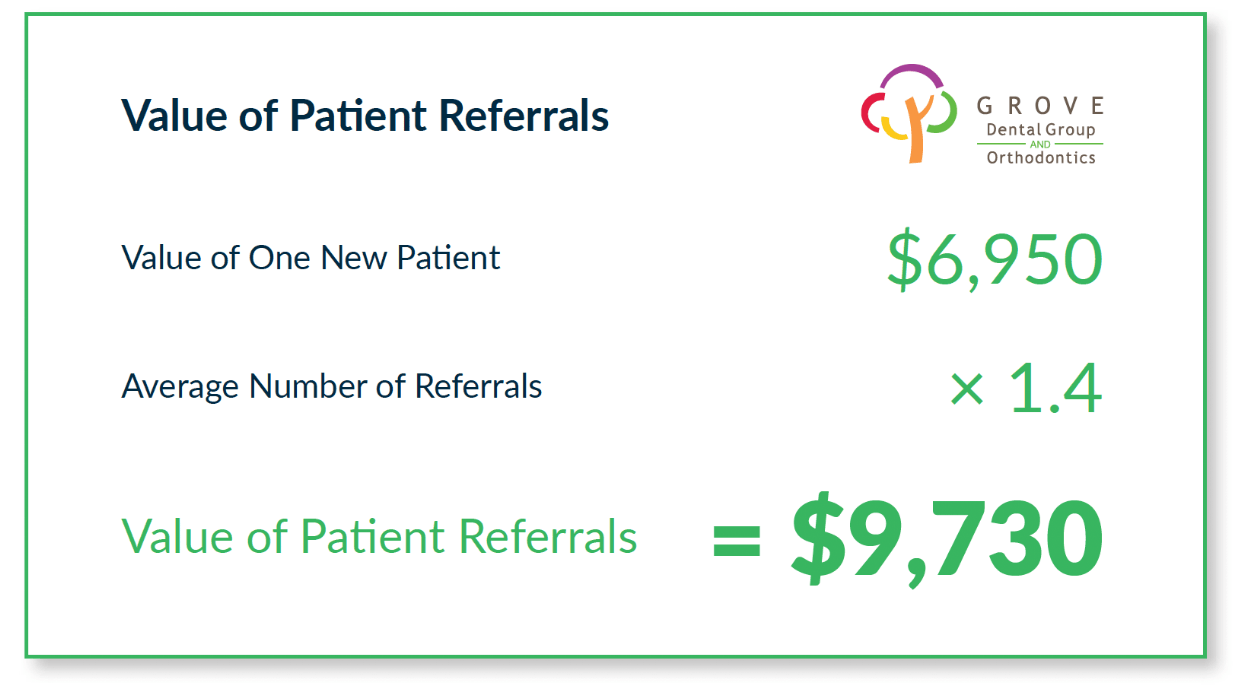
It’s critical you do not skip this step. Remember that without the acquisition of new customers from your marketing, you would have never acquired these additional new patient referrals.
What is the Total LTV of Your New Patients?
The final step is to determine the total LTV of each of your new patients.
For this calculation, we add the value of each new patient ($6,950) to the production generated by your new patient referrals ($9,730) to calculate the total LTV of each of your practice’s new patients ($16,680).
Grove Dental Example:
$16,680
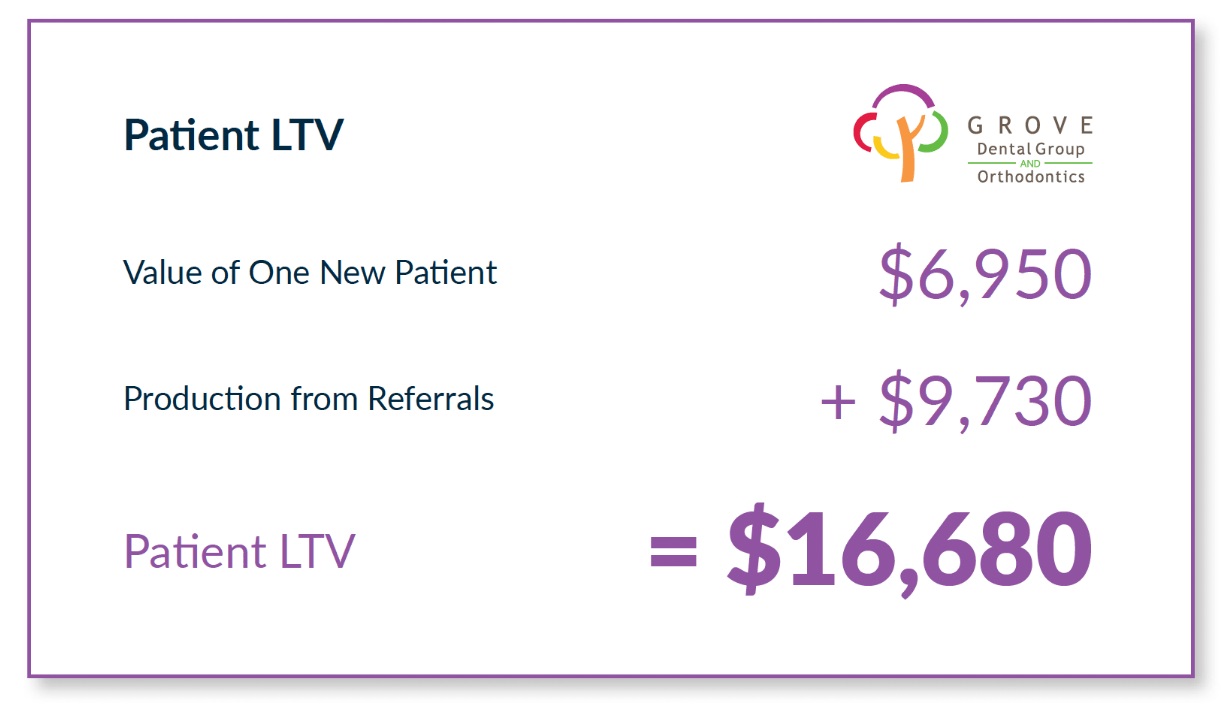
Now that we have calculated and determined an accurate value of your new patients, in Part 2, we will take an in-depth look at the anticipated potential direct mail response rates and how to forecast and calculate your potential ROI that direct mail can produce for your practice.

Direct Mail Response Rates for General Dental Practices
Many direct mail companies that haven’t worked with a large number of dental practices will provide you with response rates based on the DMA’s (Direct Mail Association) latest statistics, which show household direct mail average response rates are 5.1%.
Unfortunately, there is very little transparency as to how this number was calculated, what industries it was based on, what call to actions were used, what duration of time these figures were calculated over, what type of direct mail piece was used, how many touchpoints were executed, and what markets these tests were located in, to name a few factors. Therefore, these figures cannot be applied to your practice.
Our approach is to give you a much more conservative potential response rate based on real-world experience working with dental practices across the country.
The potential direct mail response rates that we see from general dental practices range from 1/4–1%+ over the short term. The short term is the 1–3+ month period from the time your mailers are sent out.
Practices that are consistent with their marketing by targeting the same prospects with multiple touches and have the right creative, strategic ad copy, call to action, mailing list, and strategy will hit the top end of this range. Many will exceed these numbers.

How to Calculate Your Potential Direct Mail ROI
For our Example: we will use a quantity of 10,000 prospects targeted with direct mail. In addition, we will be conservative and use a ¼% response rate, which, if you recall, was on the low end of the targeted direct mail response rates of ¼–1%.
To calculate your potential ROI, we take the 10,000 prospects being targeted and multiply that by the forecasted ¼% response rate which equates to an increase of 25 new patients (10,000 x ¼% = 25 New Patients).
Next, multiply that by the patient lifetime value using the numbers from Grove Dental.
Finally, subtract the cost of the mailer.
As you can see, the potential ROI on your practice’s direct mail is significant. Over time, based on the numbers above, for every $1 spent on direct mail marketing, there is a return of $118.14 in production, making this one of the soundest investments you can make for your practice.
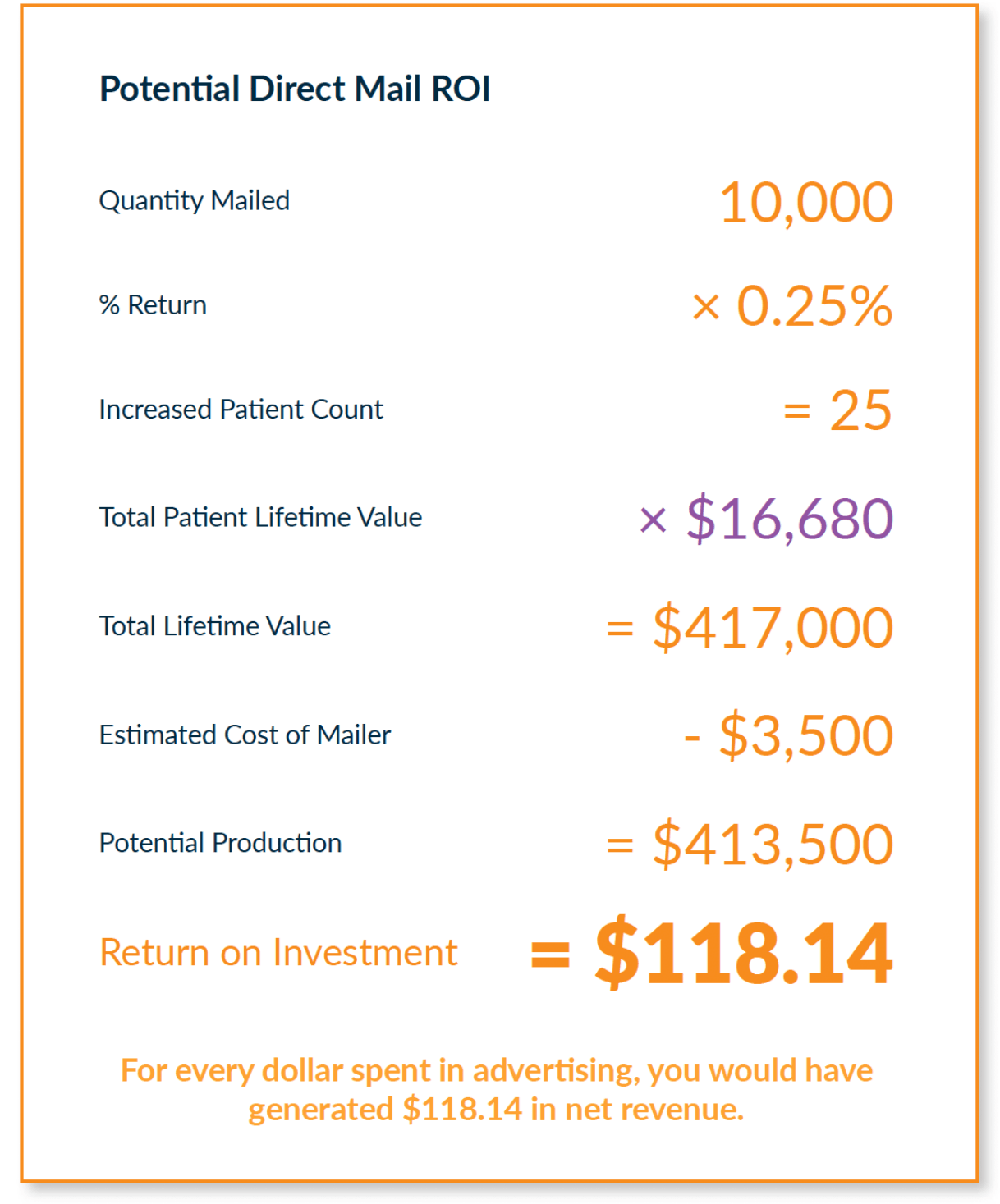
To add another layer of transparency and analyzation, let’s remove the potential production from referrals from our calculation to see how this impacts your potential ROI.
In the example below, we have replaced the total patient LTV ($16,680), which includes the production from referrals, and have replaced it with only the value of one patient ($6,950) from our calculation on page 5.
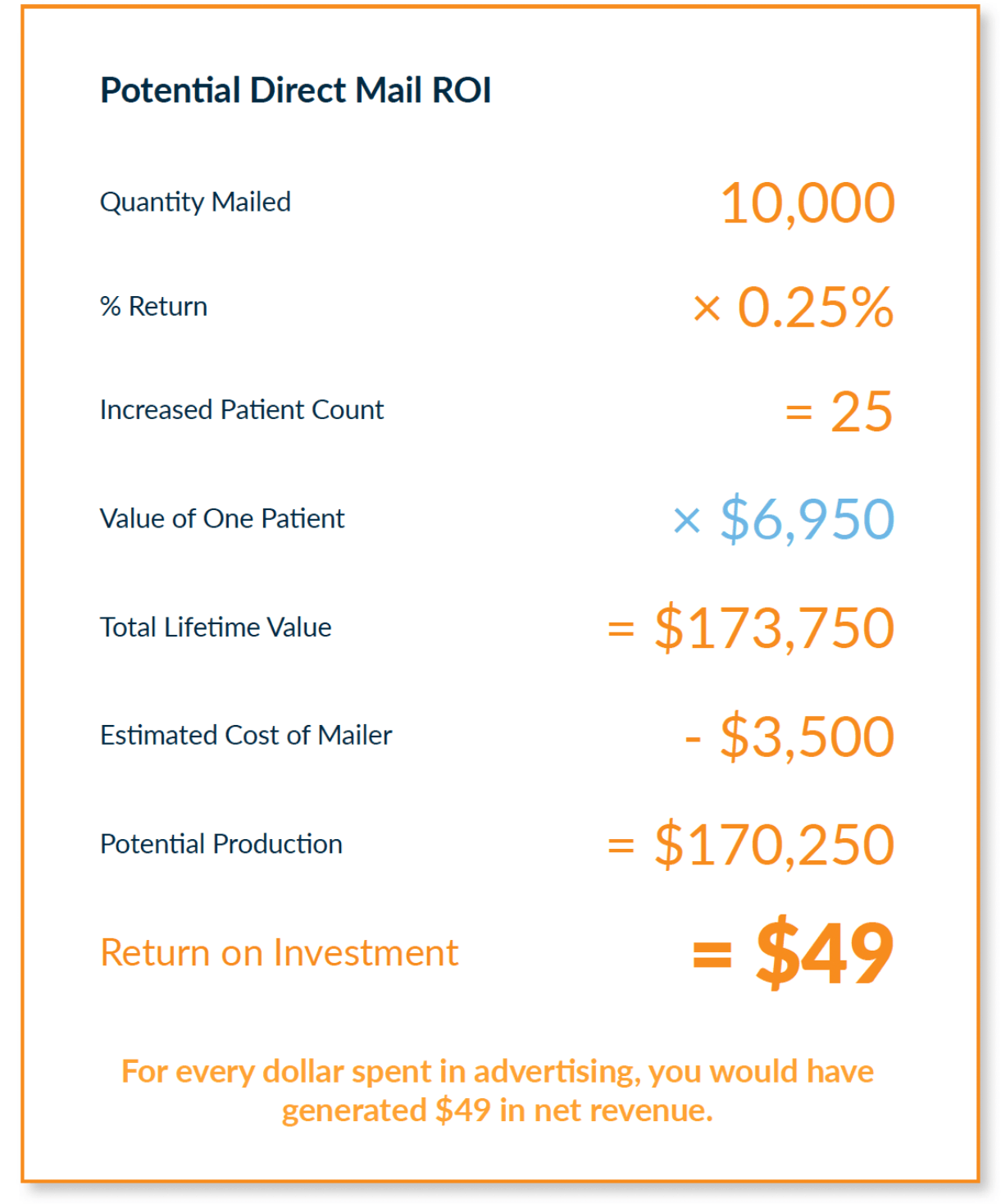
As you can see from the numbers calculated above, direct mail remains one of the best marketing investments you can make to grow your Dental Practice.